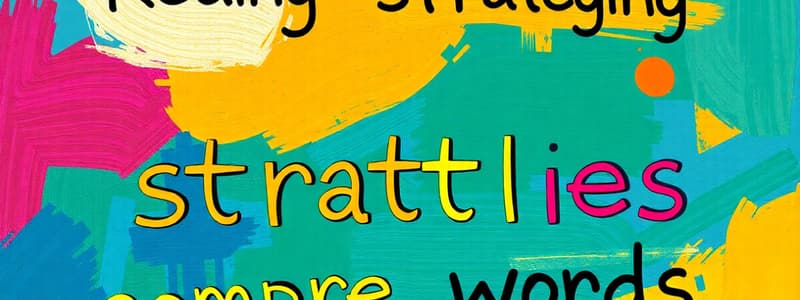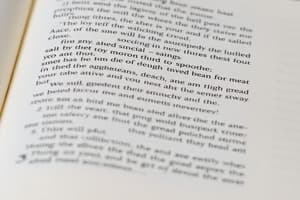Podcast
Questions and Answers
What is the primary benefit of reading with a purpose?
What is the primary benefit of reading with a purpose?
- To identify unfamiliar words and their definitions.
- To ensure comprehension and effective learning. (correct)
- To memorize every detail of the text for later recall.
- To increase reading speed and fluency.
In reading, what is the role of 'context clues' when encountering an unfamiliar word?
In reading, what is the role of 'context clues' when encountering an unfamiliar word?
- To skip the unfamiliar word and continue reading for overall understanding.
- To immediately look up the word in a dictionary.
- To provide hints about the word's meaning from surrounding text. (correct)
- To replace the need to decode the word phonetically.
Which of the following best describes 'morphemes' in the context of word decoding?
Which of the following best describes 'morphemes' in the context of word decoding?
- The smallest units of sound in a language.
- The basic spelling patterns used to pronounce words.
- The smallest meaningful parts of words, including prefixes, roots, and suffixes. (correct)
- The rules of grammar that dictate sentence structure.
When decoding multisyllabic words, applying basic spelling patterns primarily helps to:
When decoding multisyllabic words, applying basic spelling patterns primarily helps to:
What is the main purpose of making predictions while reading?
What is the main purpose of making predictions while reading?
According to the five-step reading process, what is the purpose of 'previewing' a text before reading in detail?
According to the five-step reading process, what is the purpose of 'previewing' a text before reading in detail?
In the context of reading comprehension, what does 'paraphrasing' primarily aim to achieve?
In the context of reading comprehension, what does 'paraphrasing' primarily aim to achieve?
Which sequence correctly represents the order of components in a word based on morphemic structure?
Which sequence correctly represents the order of components in a word based on morphemic structure?
What is the broader term that encompasses both prefixes and suffixes in word structure?
What is the broader term that encompasses both prefixes and suffixes in word structure?
Which of these methods is LEAST helpful when trying to make predictions about a story?
Which of these methods is LEAST helpful when trying to make predictions about a story?
What is the primary purpose of visualization as a reading strategy?
What is the primary purpose of visualization as a reading strategy?
When should visualization be employed as a reading strategy?
When should visualization be employed as a reading strategy?
Which of the following is LEAST helpful when clarifying the meaning of an unfamiliar word or concept in a text?
Which of the following is LEAST helpful when clarifying the meaning of an unfamiliar word or concept in a text?
What distinguishes implied information from explicit information in a text?
What distinguishes implied information from explicit information in a text?
What is the process of inference in reading comprehension?
What is the process of inference in reading comprehension?
Why is it important to draw evidence from a text when discussing or writing about it?
Why is it important to draw evidence from a text when discussing or writing about it?
What is the core principle of paraphrasing?
What is the core principle of paraphrasing?
When summarizing a text, which aspect is LEAST critical to include?
When summarizing a text, which aspect is LEAST critical to include?
In the process of analyzing and synthesizing two texts, what is the primary goal of synthesis?
In the process of analyzing and synthesizing two texts, what is the primary goal of synthesis?
What is the key difference between comparing and contrasting?
What is the key difference between comparing and contrasting?
Flashcards
Reading with Purpose
Reading with Purpose
The process of understanding the purpose of your reading and actively engaging with the text.
Five-Step Reading Process
Five-Step Reading Process
A five-step process for improving reading comprehension: Prepare, Preview, Predict, Paraphrase, and Picture.
Context Clues
Context Clues
Using the words and phrases surrounding an unfamiliar word to figure out its meaning.
Phonics
Phonics
Signup and view all the flashcards
Morphemes
Morphemes
Signup and view all the flashcards
Multisyllabic Words
Multisyllabic Words
Signup and view all the flashcards
Decoding
Decoding
Signup and view all the flashcards
Affixes
Affixes
Signup and view all the flashcards
Prediction in Reading
Prediction in Reading
Signup and view all the flashcards
Story Clues
Story Clues
Signup and view all the flashcards
Visualization
Visualization
Signup and view all the flashcards
Clarify
Clarify
Signup and view all the flashcards
Explicit Information
Explicit Information
Signup and view all the flashcards
Implied Information
Implied Information
Signup and view all the flashcards
Inference
Inference
Signup and view all the flashcards
Evidence
Evidence
Signup and view all the flashcards
Paraphrasing
Paraphrasing
Signup and view all the flashcards
Summary
Summary
Signup and view all the flashcards
Synthesize
Synthesize
Signup and view all the flashcards
Compare and Contrast
Compare and Contrast
Signup and view all the flashcards
Study Notes
Reading with a Purpose - Five-Step Process
- Prepare yourself and your environment for optimal reading.
- Preview the text to identify key information.
- Predict what will happen in the text.
- Paraphrase the text in your own words.
- Visualize the text by creating mental images.
Understanding Unfamiliar Words
- Use context clues (surrounding words and phrases) to determine the meaning of unfamiliar words.
Decoding Words
- Phonics: Sound out words.
- Morphemes: Analyze the smallest meaningful units of words (prefixes, root words, suffixes).
Understanding Multisyllabic Words
- Break down multisyllabic words using vowel and consonant patterns.
- Look for affixes (prefixes and suffixes) to assist with pronunciation.
Making Predictions
- Use story details, clues, and prior knowledge to anticipate what will happen next.
- Use the title, pictures, and synopsis as helpful clues.
- Be prepared to revise predictions if needed.
Visualization in Reading
- Create mental images of the text.
- Include details from all five senses and other relevant information in illustrations within your mind.
- Modify your visualizations as the story progress.
- Utilize visualization before, during, and after reading.
Clarifying Unclear Words or Meanings
- Review the title to refresh memory.
- Utilize keywords.
- Employ other surrounding words as clues.
Explicit and Implied Information
- Explicit information: Information directly stated in the text.
- Implied information: Information suggested but not directly stated; requires inference.
- Use direct quotes or paraphrasing for explicit information.
- Combine text with prior knowledge to infer implied information.
Making Inferences
- Identify missing information in a text or picture to draw conclusions.
- Use reasoning and knowledge from clues in the text.
Providing Textual Evidence
- Use explicit evidence to support arguments.
- Clearly state your arguments and support them with facts and evidence.
Paraphrasing
- Rewrite information in your own words.
- Properly attribute the original source.
Summarizing
- Condense information into a concise retelling.
- Include the who, what, when, where, why, and how.
- Include a topic sentence conveying the central idea.
- Omit unnecessary details and characters.
Analyzing and Synthesizing Texts
- Analyze: Understand each text separately, identifying:
- Text type
- Topic
- Purpose
- Main idea/argument
- Supporting reasons/evidence
- Unclear information
- Critical questions
- Synthesize: Combine insights from both texts, focusing on:
- Reviewing notes and texts
- Comparing types, purposes, main ideas
- Comparing reasons, evidence, and context
- Identifying similarities and differences
- Recognizing where each text fills gaps in the other and strengthens arguments.
Comparing and Contrasting
- Compare: Highlight similarities between subjects.
- Contrast: Highlight differences between subjects.
- Use a Venn diagram to visually represent comparisons and contrasts.
Distinguishing Facts from Opinions
- Fact: Proven true or verifiable statement.
- Opinion: Personal belief or judgment.
- Questions for determining fact versus opinion:
- Can the information be proven?
- Does the sentence reflect a personal belief?
Studying That Suits You
Use AI to generate personalized quizzes and flashcards to suit your learning preferences.




